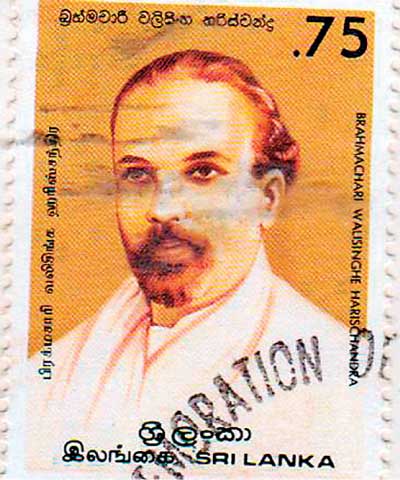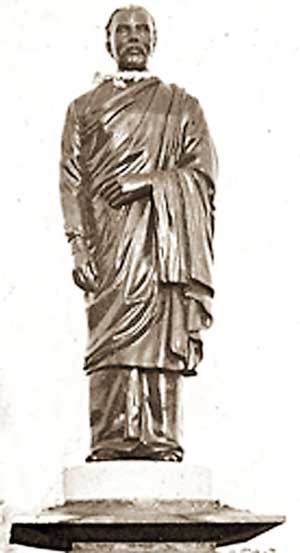Friday Dec 05, 2025
Friday Dec 05, 2025
Saturday, 2 July 2016 00:00 - - {{hitsCtrl.values.hits}}
 A student is asked, “Who is Walisinghe Harischandra?” He answers: “He is the one who manufactures various kinds of flour”. This was revealed by a university don recently at a book launch.
A student is asked, “Who is Walisinghe Harischandra?” He answers: “He is the one who manufactures various kinds of flour”. This was revealed by a university don recently at a book launch.
The student happened to be one who attends a ‘Daham Pasala’, which makes it even worse because Walisinghe Harischandra is a name that is mentioned often as Buddhist revivalist, the ‘Saviour of Anuradhapura’.
The university don insists on books about national heroes. I tend to disagree. There is no dearth of books. For so many years there have been publications on important personalities.
Most Venerable Madihe Pannasiha Mahanayaka Thera initiated the publication of books on national heroes some years back under the auspices of the Maharagama Dharmayatanaya and the Sasana Sevaka Society. I remember W.J.M. Lokubanadara getting the Department of Cultural Affairs to publish a series when he was Minister of Cultural Affairs.
In school during our era many decades ago, we invariably learnt about such personalities in the History class. In recent times there has been so much discussion about how history should be taught, whether it should be part of some other subject or whether history should be taught at all. It’s so difficult to keep a tab on what’s going on.
Having read the university don’s remarks in a Sinhala newspaper, I glanced through my little library to refresh my own memory about Brahmachari Walisinghe Harischandra (July 1876 – September 1913) and share with the readers.
Hailed as a social reformer, historian, author and Buddhist revivalist, he was greatly influenced by Anagarika Dharmapala and joined the Mahabodhi Society established by the latter, serving as assistant secretary and later as secretary and playing a key role in the campaign ‘Save Buddhagaya’.
In the January 1911 Mahabodhi Journal, Anagarika Dharmapala makes reference to Walisinghe Harischandra as his “faithful pupil” in the article titled ‘Our Twenty Years’ Work’.
Anagarika Dharmapala writes: “Another philanthropic scheme that I started was to help the poor peasant Buddhist living in the village

of Hinuduma, in Ceylon. It is situated in a romantic valley, away from civilisation, and Jesuit fathers of the Roman Catholic Church had gone there, and having found the villagers simple, and ignorant, and very poor, adopted methods to easily convert them wholesale to Jesuitism.
“When I heard of the abominable methods adopted by Jesuit fathers for the conversion of these poor, illiterate Sinhalese, I decided to open a Sinhalese school in the village, and to give whatever support that was in my power to have them brought back to their ancient faith. With the money I received from the Trustees of my father’s estate I purchased a plot of land with a small cottage and opened a school. In this I was greatly helped by my faithful pupil Brahmachari Harischandra and my own brothers. There is work to be done on this line yet, and I hope help will be forthcoming gave the poor peasants from the diabolism of the Jesuit fathers.”
Brahmachari Harischandra played a very active role in getting Anuradhapura declared as a sacred city. Though it was always universally accepted as a sacred city, over the centuries it became ‘a city of ruins’ and had to be revived. He worked hard to get the ancient shrines restored. Having observed the ‘Discipline of Celibacy’ before the Maha Sangha in January 1899, he came to Anuradhapura to launch the campaign ‘Save Anuradhapura’, which he did by delivering the first talk at the Sri Maha Bodhi. His was a non-violent struggle to get the government of the day to bring back the first capital of Sri Lanka to its pristine glory.
He founded the ‘Ruvanveli Chaityawardhana Samitiya’ thereby leading the movement for the restoration of the Maha Cetiya as seen today.
Though he did not live to see the fruits of his labour (he died when he was 37), with the birth of the new town in February 1949 under the D.S. Senanayake Government, the area covering the places of worship were cleared of houses, shops and other unwanted premises, except for stalls to sell flowers, joss sticks and other items for worship.
He wrote several books on Anuradhapura to create awareness and educate the public on the city’s importance.
Born in Negombo as the son of Walisinghe Handrick de Silva, he was named Edward at birth and received his early education at St. Mary’s College, Negombo and Wesley College, Colombo. Though he was to start a legal career he soon gave up and devoted his time to nationalist and Buddhist work. He preferred to be called Edward de Silva Walisinghe and later he was known as Brahmachari Walisinghe.
As a tribute to his yeoman service, a statue has been erected in the city and the Anuradhapura national school has been named after him. A stamp in his honour was released in May 1986.